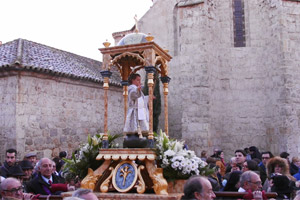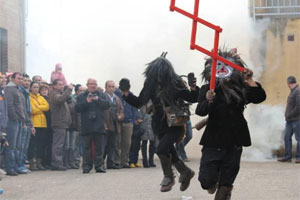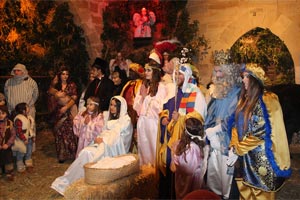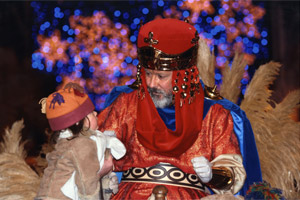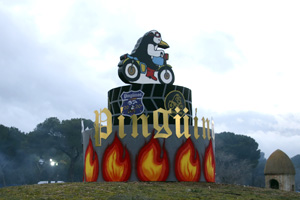Spring Festival of Murcia
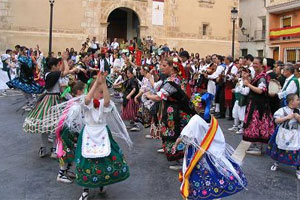
What is the Murcia Spring Festival?
The Murcia Spring Festival, also known as the Spring Festival or simply the "Feria de Murcia", is a popular celebration that takes place in the city of Murcia, Spain, during the month of April. The festivities usually last ten days and are full of activities for all ages.
The main event of the Murcia Spring Festival is the famous Bando de la Huerta parade, which takes place on the Tuesday of the fair week (Easter Tuesday). This parade is a tribute to Murcian agriculture and culture, and features decorated floats, regional costumes, folk groups, and many other attractions.
The week is made up of days that are a festivity in themselves, such as the burial of the sardine, the day of the meat pie or the Romería de la Fuensanta that puts the finishing touch to these celebrations. Other activities include bullfights, concerts, fireworks shows, children's activities, and amusement parks. In addition, during the fair, many bars and restaurants in the city offer tapas and drinks at reduced prices.
The Murcia Spring Festival is one of the most important celebrations in the city, and attracts thousands of visitors from all over Spain and abroad.
Origin and History
The Murcia Spring Festival has its origins in the celebration of the spring equinox, which dates back to Roman times. During this time of year, the end of winter and the arrival of spring were celebrated, which was considered a moment of rebirth and rejuvenation.
Over time, this celebration evolved to include the worship of the goddess Ceres, the protector of agriculture and fertility, and became a Christian festival known as the "Fiesta de la Flores" or "Fiesta de la Cruz". During this festival, the people of Murcia decorated the streets with flowers and crossed the streets with altars decorated with flowers.
In the 18th century, the festivities were moved to the September Fair, but in 1887 it was decided to move them back to the spring to avoid the summer heat. Thus was born the "Spring Fair", which today is one of the most important celebrations in Murcia and one of the most famous fairs in Spain.
Days and Activities
In addition to the Bando de la Huerta, there are other noteworthy moments during the days that make up this festival.
Bando de la Huerta Parade
It is one of the most important events of the festival and takes place on the Tuesday of the fair week. It is a parade in which decorated floats with themes of the Murcian orchard, folk groups, music bands, and many other attractions participate.
Day of the Meat Pie
It is celebrated on the day after the Bando de la Huerta parade. Several city's restaurateurs offer attendees the tasting of this dish. This celebration is a relatively modern addition to the festival.
Burial of the Sardine
The Burial of the Sardine is a celebration that takes place in the city of Murcia, Spain, on the Saturday after Holy Week. The festival symbolizes the victory of Don Carnal over Doña Cuaresma and is a pagan festivity that is divided into three parts: the arrival of the sardine, the reading of the will, and the Great Burial of the Sardine Parade. The sardine groups organize the event and, in the days leading up to it, liven up the city with their parades and different activities. The will, preceded by a playful parade, is read by Doña Sardina and is a parody of current events. The Great Burial of the Sardine Parade is the culmination of the celebration and is an allegory of the victory of Don Carnal over Doña Cuaresma, in which carnival returns to ward off the rigors and privations of the recently concluded Holy Week.
The celebration has its origins in the 19th century when a group of students decided to form a burlesque funeral procession presided over by a sardine. The festival has become one of the most important in the city and was declared of International Tourist Interest in 2006. The arrival of the sardine is the first great event of the sardine festivities before the will, the reading of which travels the streets of Murcia before its "solemn" reading, and the Great Burial of the Sardine Parade is the culmination of the "Spring Festival". The celebration attracts many visitors and is a magical night not to be missed in the city.
Romería de la Fuensanta
It takes place at the end of the Murcia Fair to honor the Patroness, Our Lady of Fuensanta. During the procession, the image of the Virgin is carried on the shoulders by the Knights of Fuensanta, who are members of the Royal Brotherhood of the Virgin Our Lady of Fuensanta. The final destination of the procession is the Sanctuary of Fuensanta, where the image rests throughout the year, except for the two festivities celebrated in the City of Murcia.
And many activities
In addition, there is a wide variety of activities for all tastes and ages. Some of the most outstanding activities are:
Contests: During the fair, various contests are held, such as the contest of huertanos and huertanas, the float contest, the regional costume contest, and the tapas contest.
Children's activities: There is a great variety of activities for the little ones, such as puppet shows, storytelling, games, and workshops.
Shows: During the fair, there are numerous concerts and shows of different genres, such as live music, theater, dance, and fireworks.
Amusement Park: In the fairgrounds, there is a wide variety of attractions for all ages, from the Ferris wheel to roller coasters.
Gastronomy: During the fair, you can taste a great variety of typical Murcian dishes and tapas, such as paella, zarangollo, meat pie, and paparajotes. These are just some of the highlights of the Murcia Spring Festival. The fair offers a wide variety of activities to enjoy a few days full of fun and culture.
What to see in Murcia
Murcia is a city with a great historical, cultural, and gastronomic wealth. Some of the most outstanding places of interest that can be visited in the city are:
- Cathedral of Murcia: The Cathedral of Murcia is one of the most emblematic monuments of the city. It is a Gothic style building dating back to the 14th century and has an impressive facade and a spectacular interior with a large amount of artistic details.
- Real Casino of Murcia: The Real Casino of Murcia is a historic building built in the 19th century. It is one of the most important cultural and social institutions in the city and has an impressive library, a game room, and an art gallery.
- Salzillo Museum: The Salzillo Museum is a museum dedicated to the sculptor Francisco Salzillo, one of the most important artists in the Murcia region. The museum has a large collection of Salzillo's works and is a must-see for art lovers.
- Museum of Fine Arts of Murcia: The Museum of Fine Arts of Murcia is a museum that has an impressive collection of art ranging from the Middle Ages to the present day. The museum has works by renowned artists such as Francisco de Zurbarán, Velázquez, and Goya.
- Plaza de las Flores: Plaza de las Flores is an emblematic place in the city, where you can find numerous flower and plant stalls, as well as café and bar terraces. It is a perfect place to relax and enjoy the city's atmosphere.
Recommended handicrafts and shopping
Murcia has a wide range of handicrafts and typical products that you can acquire during your visit. Some of the most outstanding options are:
- Murcia ceramics: Murcia ceramics are well known for their traditional and colorful style. You can find plates, vases, tiles, and other decorative objects in specialized stores.
- Lorca embroideries: The city of Lorca, located near Murcia, is known for its traditional embroideries. You can find tablecloths, towels, and other hand-embroidered products in specialized stores.
- La Encarnación carpets: In the town of La Encarnación, located near Murcia, esparto and palm carpets are made that are very popular. They are perfect for decorating any space and can be found in specialized stores.
- Gourmet products: The Murcian orchard is well known for the quality of its fresh products, such as fruits, vegetables, cheeses, and sausages. You can acquire these products in local markets and specialized stores.
- Clothing and accessories: In the center of Murcia, you will find a wide range of fashion and accessory stores, where you can find designer clothing and exclusive products.
In Murcia, you will find a great variety of handmade and quality products that reflect the rich culture and traditions of the region.
What to eat in Murcia
The gastronomy of Murcia is very varied and rich in flavors and aromas, thanks to its proximity to the Murcian orchard, one of the most important in Spain. Some of the most typical dishes that you can enjoy in Murcia are:
- Rice with rabbit and snails: it is a very popular dish in the region and is prepared with rice, rabbit, snails, vegetables, red pepper and saffron. It is a hearty and flavorful dish.
- Zarangollo: it is a dish made with zucchini, onion, egg and olive oil. It is usually served as a tapa or as a side dish.
- Murcian salad: it is a very fresh and healthy salad, made with tomato, onion, olives, tuna and hard-boiled egg. It is dressed with olive oil and vinegar.
- Paparajotes: it is a typical dessert from Murcia, made with lemon tree leaves, coated in a batter of flour, egg and milk, and fried. They are usually served sprinkled with sugar and cinnamon.
- Migas: it is a very popular dish in the region and is made with bread, olive oil, garlic, red pepper and bacon. It is a very hearty dish and perfect for cold winter days.
And of course, you can also enjoy excellent wines from the region, such as Jumilla wine or Bullas wine, which are perfect to accompany any typical dish from the region.

